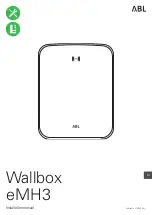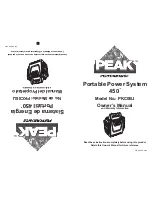
43
44
◎ COMMON PROBLEMS AND PRECAUTIONS FOR THE POLARON AC/DC CHARGER
- The charger has been turned on, but the LCD Screen is off.
. Check that the external power source is an appropriate source.
. This charger should be operated only with the types of power sources that are indicated
on the specifications.
. Please contact the A/S center for additional information.
- The charger does not recognize the batteries.
. Check that the battery connections and the polarity are correct.
. Worn or excessively used cables should be replaced.
. Replace damaged or defective cells in the battery pack.
- Battery voltage is low after the charging process has been completed.
(Cell voltages: NiCd, NiMH less than 1.2V or LiPo, LiIon less than 3.6V or 3.7V)
. Increase the max charge capacity if the final results are too low.
. Control Peak sense of NiCd, NiMH, if the values are too low or high
. Replace worn or damaged charge cables.
- Discharging mode cannot be accessed.
. Check to see if the the preset battery voltage and the cell voltage match.
. Change damaged or defective cells in the battery pack.
- The mAh/time is too low after the charging process has completed.
. The battery may not be fully charged.
. Fully charge the battery and repeat the discharge process. Perform a cycle process to
improve the battery capacity for worn out or infrequently used batteries.
. Reduce the discharge cut-off voltage values that have been programmed too high.
Control the discharge ratio.
. Check that the preset battery voltage and the cell voltage values match.
. For discharging with over current, repeat the discharge process to discharge the
remaining current. For example: for discharging processes exceeding 5A, cool down
the battery and repeat the discharge with 1A.
- Charging Lithium type batteries.
. Use a balance board with an EH to XH cable (MUST).
. Do not charge Lithium battery packs above the maximum charge rate. Using excessive
charge rates can damage the pack and be dangerous. Generally, Lithium Polymer
packs should not
be charged above 3C. However, some newer packs do allow charging at up to 5C, but
charging at these higher rates will reduce the life of the pack.
◎ NiCd, NiMH BATTERY SAFETY
◎ Pb BATTERY SAFETY
◎ LiIon, LiPo, LiFe BATTERY SAFETY
- With charging new NiCd/ NiMH batteries for the first time, the process may terminate
within minutes. This stoppage does not indicate a problem. This stoppage results from an
unstabilized battery. To stabilize the batteries, charge the batteries either after increasing
the delta peak value or after performing a discharging process followed by a cooling down
period.
Do not use the batteries, if the charged capacity of the battery exceeds the specifications
for the battery capacity. If you experience repeated terminations upon charging, repeat the
charge and discharge process by at least 5 times and then repeat the charging process.
Premature terminations may occur up to the third time that the battery has been charged.
- Pb batteries need to be charged every day. If the charged capacity of the battery falls
below 50%, this battery may not be recharged. The average charge time of a Pb battery
is 4-5 hours. Do not charge with an automobile battery, as the charger may be seriously
damaged.
- Only charge batteries that have a Lithium ion or Lithium polymer mark.
- Do not charge batteries that have a Lithium mark. Charging Lithium mark batteries will damage
the batteries and may cause fires or personal injuries.
- Only charge batteries labelled with these cell voltages ( 3.3V / 3.6V / 3.7V ).
- Place the charger and battery on a non-flammable surface during the charging process.
- NEVER charge Lithium ion/Polymer/Fe batteries inside a vehicle.
- Always ensure that the charger is correctly programmed for the battery being charged,
checking both the voltage and the capacity. Be particularly careful with series/parallel battery
packs or using packs of different specifications with the same charger.
- Never charge at a rate exceeding the recommended specifications by the cell manufacturer.
(VERY DANGEROUS).
- Do not leave Lithium ion/Polymer/Fe batteries unattended during the charging process.
Continual monitoring of the batteries is very important.
- Every few minutes, check the temperature of the battery being charged. If the battery
becomes hot to the touch, disconnect it from the charger immediately and allow to cool. Do not
restart the charging process until both the battery and the charger have been checked for
compatibility
and the charger settings have been confirmed as being correct.
- In the unlikely event of the Lithium ion/Polymer/Fe battery catching fire, DO NOT use water to
attempt to put the fire out! Instead, use sand or a fire extinguisher designed for electrical fires.



































